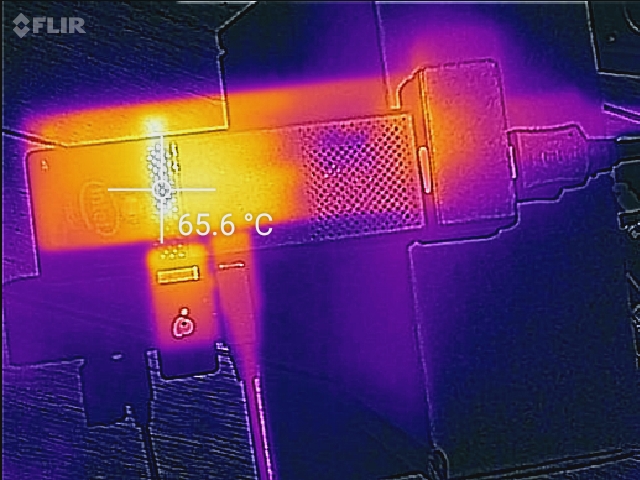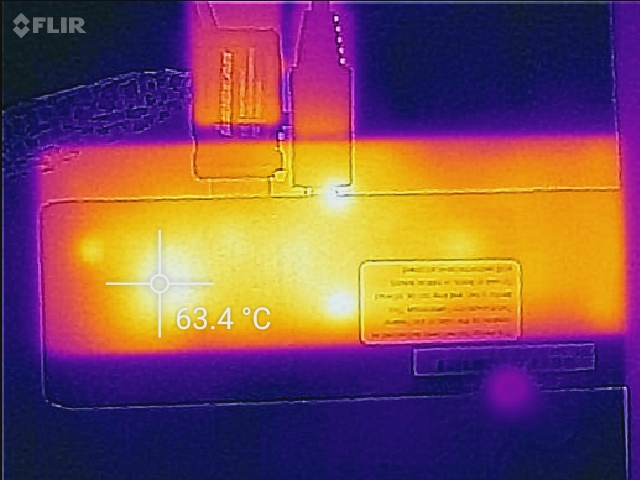The Intel Compute Stick (Cherry Trail) Review
by Ganesh T S on January 14, 2016 8:00 AM EST- Posted in
- Systems
- Intel
- Cherry Trail
- HDMI Stick
- CES 2016
- Compute Stick
Power Consumption and Thermal Performance
The power consumption at the wall was measured with a 1080p display being driven through the HDMI port. In the graphs below, we compare the idle and load power of the Intel PPSTK1AW32SC with other low power PCs evaluated before. For load power consumption, we ran Furmark 1.15.0 and Prime95 v28.7 (32-bit) together.


Compared to the Bay Trail Compute Stick, the Cherry Trail one has higher idle and load power consumption numbers. Given the upgraded Wi-Fi, the idle number can probably be justified. The load number is more due to the upgraded GPU which delivers much better performance while also consuming as much power as possible while staying within the acceptable thermal envelope.
Our thermal stress routine starts with the system at idle, followed by 30 minutes of pure CPU loading. This is followed by another 30 minutes of both CPU and GPU being loaded simultaneously. After this, the CPU load gets removed, allowing the GPU to be loaded alone for another 30 minutes. The various clocks in the system as well as the temperatures within the unit are presented below.
According to the official specifications, the junction temperature of the Atom x5-Z8300 is 90 C. The thermal solution is able to keep all temperatures around the 80C mark without excessive throttling. In the absence of any GPU loading, the CPU cores maintain a 1.6 GHz speed. We didn't observe the cores operating at the maximum burst frequency at all (1.84 GHz). With GPU loading into the picture, the cores can drop down to as low as 900 MHz even with the CPU load active. The GPU shunts between 380 MHz and 500 MHz depending on the load and available thermal headroom. One disappointing aspect is that the idling temperature of 57 C for the CPU cores is a lot higher than what we would like.
Using the Android version of the FLIR One thermal imager, we observed the chassis temperature after the CPU package temperature reached the steady state value in the above graph.
We see that the chassis remains below 66 C even when the internal SoC is at 80 C.














80 Comments
View All Comments
AmdInside - Friday, January 15, 2016 - link
Can you comment how well it works as a Minecraft vanilla server? I picked up a Liva before and it kept crashing on Windows and Ubuntu for some reason so had to return it but wanted to buy something similar againPragmaticPraxis - Saturday, January 16, 2016 - link
Does anyone have any experience with using a Compute Stick headless, using Remote Desktop? Do you need some sort of HDMI dongle?I ask because I see a use for me as a light weight FlexLM license server for a traveling computer lab environment. But I would want to simply plug it in to power and be done. if I need to have it connected to K, V & M then a cheap Windows tablet starts looking more attractive, at least when it comes to travel.
jasperjones - Sunday, January 17, 2016 - link
I used to visit Anandtech all the time. Now I rarely come here. Here's the reason: I think this review has little relevance for real life.Instead of what you're doing, I would compare this device with:
- RPi 2
- Apple TV
- Nexus Player
- Amazon Fire TV
Also, I would comment on Linux performance. Seriously, 2GB RAM and Windows??
andrewaggb - Monday, January 18, 2016 - link
I somewhat agree. The review is about the technical details, but some actual use cases would be nice as well. I'm actually somewhat interested in the cheap version (32gb, 2gb, atom) but I'd like to know that it can handle my use cases.How does itunes and movies/shows/audio from itunes work on it (versus say an apple tv). I'm a
big fan of the new apple tv, but it cost me more than the compute stick and does a lot less.
If I use it as a steam link to stream a game from a more powerful pc, how well does it work?
Does XBMC or a similar front end work well.
Can you install linux on it, boot from usb (with legacy bios), etc?
mkozakewich - Sunday, January 17, 2016 - link
These are basically the same thing as equivalent tablets, except without the screen. I'd take a Chuwi Vi8 instead.yon1000 - Monday, January 18, 2016 - link
I truly don't understand the Price of the compute sticks - 150$+Windows Tablets cost as low as 100$ with the same processor and RAM these tablets have. and they add an HD display, a battery, Bluetooth and other hardware stuff, and above all they come with Windows 10 Installed and 1 year license of Office 365.
So how come the compute sticks cost 50% more compared to Windows Tablets?
piasabird - Monday, January 18, 2016 - link
I consider a compute stick to be a toy. Windows will not work on it well. If it came with some kind of Linux like a tablet has it might be comparable to a tablet, but not a desktop. It is just a toy.velanapontinha - Monday, January 18, 2016 - link
Ads are on overdrive on this website! Seriously, a giant ad for something related to National Geographic and an enormous "find a mexican lady" youporn-like photo is NOT the way to keep this site a respected one. Please stop this. Income is not everything, Purch!074geodude - Monday, January 18, 2016 - link
My ad blocker only showed two blocked ads, that's actually really good. I've seen many sites that are a lot worst, some with 30+ blocked ads.BurntMyBacon - Monday, January 18, 2016 - link
Can we get a mainstream build for comparison just to see how far these miniature systems have come? It would also be a good comparison to show where these systems might be sub par. You could break out a separate section of the article or even a whole separate article on the state of miniature computing. This will be especially interesting when the Core-M sticks arrive.